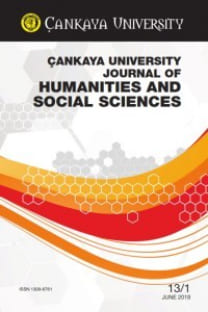Unreliable Narrator Trapped in her Narrative: Absence of Meaning in Gilman’s “The Yellow Wallpaper”
anlatıcının güvenilmezliği, anlatı, farklılaşma, kimlik, “Sarı Duvar Kağıdı”
Unreliable Narrator Trapped in her Narrative: Absence of Meaning in Gilman’s “The Yellow Wallpaper”
___
- Armitt, Lucie. Theorising the Fantastic (New York: Arnold, 1996).
- Bennett, Andrew and Nicholas Royle. An Introduction to Literature, Criticism and Theory (New York: Prentice Hall, 1995).
- Davis, Colin. After Poststructuralism: Reading Stories and Theory (London: Routledge, 2004).
- Eagleton, Terry. Literary Theory: An Introduction (Oxford: Blackwell, 1983).
- Gilman, Charlotte Perkins. The Yellow Wallpaper and Other Writings (New York: Bantam Classic Book, 1982).
- Gilman, Charlotte Perkins. “Why I Wrote The Yellow Wallpaper” The Forerunner, October Issue, (1913), pp.1-3.
- Green, Keit and Jill LeiBihan. Critical Theory and Practice: A Coursebook (London: Routledge, 1996). Hawkes, Terence. Narrative Fiction: Contemporary Poetics (London: Routledge, 1983).
- Murton, Michelle Mock. “Behind the “barred windows”: The Imprisonment of Women’s Bodies and Mindsin Nineteenth - Century America,” WILLA, IV (1995), pp.22-26. Norris, Christopher. Deconstruction: Theory and Practice (London: Routledge, 1988).
- Rheingold, Beth Snyder. Charlotte Perkins Gilman’s “The Yellow Wallpaper”: A Poetics of the Inside, retrieved from: http://www.womenwriters.net/domesticgoddess/snyder.htm.
- Schwartz, Lynne Sharon. Introduction to The Yellow Wallpaper and Other Writings, in Perkins Gilman (New York: Batman Classic Book, 1984).
- Selden, Raman. Practicing Theory and Reading Literature: An Introduction (Hertfordshire: Harvester Wheatsheaf, 1989).
- Taylor, E. Victor and Charles E. Winquist. Encyclopedia of Postmodernism (London: Routledge, 2001). Wolfreys, Julian. Introducing Criticism at the 21th Century (Edinburgh: Edinburgh University Press, 2002).
- Wolfreys, Julian and William Baker. Literary Theories: A Case Study in Critical Performance (London: Macmillan Press, 1996).
- ISSN: 1309-6761
- Yayın Aralığı: Yılda 2 Sayı
- Başlangıç: 2004
- Yayıncı: Çankaya Üniversitesi
Literary Text Translations: Problematic Aspects of Cultural Barriers
The Valorization of Nature in William Wordsworth’s “Tintern Abbey”
Challenges to Ekphrastic Poetry: Carol Ann Duffy’s “Standing Female Nude”
Dehen Altıner’in Sevgili Üniversite Romanında Kurmaca Gerçeklik Üzerine
Attitudes of University Faculty Towards English Medium Instruction in Turkey
Zeynep ÖLÇÜ, Betil Eröz TUĞA
Unreliable Narrator Trapped in her Narrative: Absence of Meaning in Gilman’s “The Yellow Wallpaper”
